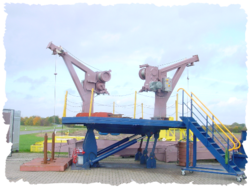· HINGED SCREW TYPE
The majority of the older frigates and destroyers retain the hinged screw type of davits for general use. These davits can be turned in or out to the desired out reach by rotating a handle connected to a worm and wormwheel, the latter operating a screw thread on the extending arm. The davit arms are of I-bar section and so shaped that the boat, in the inboard stowed position, is upright when bearing against the griping pads. The weight of the boat is taken on keel chocks fitted to each davit.
The disadvantage of this type of davit lies in their hand operation and the fact that independent control of each of a pair can result in undue strains on the davits and operating gear due to unsynchronized movements.
· GRAVITY TYPE
This consists of two portions, the davit arm and the deck frame which forms the runway for the arm. When the boat is being lowered the davit arm travels down the runway until it reaches a fixed stop by which time the boat is clear of the ship's side and disengaged from the davit head hook or 'tusk' which takes the weight of the boat when turned in. Continued veering on the winch allows the boat to travel vertically downwards. During the hoisting operation the ball-weight on the hoist wire engages a stop at the davit head, whereupon the boat and davit arm move as one until the fully housed position is reached. During this latter stage the weight of the boat is automatically transferred to the hook or tusk, thus relieving the tension in the hoist wire.
· PIVOT TORQUE TYPE
This has a deck frame and davit arm which together with the boat hinges about the deck pivot. To overcome the initial resistance to hinging outboard, should the ship have an adverse heel, a coiled spring is fitted between deck frame and davit arm. This spring is designed with sufficient effort to bring the C.G. of the davit outboard of the pivot pin under all normal angles of ship heel. As in the gravity type davit the weight of the boat is taken by a hook or tusk at the davit head, engagement or disengagement with which occurs during the hinging process.
· TRAVERSING GANTRIES
Traversing gantries are employed in aircraft carriers where the boats are stowed in boat bays at gallery deck level. These enable the boats to be lifted clear of the crutches (usually hinged), traversed outboard and lowered well clear of the ship's side. To allow for the rise and fall of the boat whilst still attached to the falls, a compensating mechanism is fitted in the lead of wire from the winch. This gear is designed to automatically 'shorten' or 'lengthen' the falls in phase with the boat's vertical movement. A man at the forward and after ends of the boat is able to retain the disengaging hook and the fall block together without difficulty.
The latest ships are equipped with either gravity or pivot torque types. Both are fully power operated and employ a single wire for boat hoisting and turning the boat to the stowed position, thus economizing considerably in manpower. Both davits of a pair are operated by a common drive and the problem of synchronized operation does not arise.
Power is not required for lowering a boat, control being exercised simply by a brake on the winch. The winches are fitted with cranked handles for operation should power fail when raising a boat. Neither of these types of davit have arrangements for combating wave motion so that the use of the nylon grommet or strop (foul weather pendant) becomes an essential safety measure.
All davits are tested with a static load of twice the working load and a running load of one and a half times the working load. In the latter case the boat is raised and lowered (or traversed if applicable) so as to test all parts of the system throughout its designed range.










4 comments:
Couldnt agree more with that, very attractive article
Thanks for an idea, you sparked at thought from a angle I hadn’t given thoguht to yet. Now lets see if I can do something with it.
this post is very usefull thx!
Hi there, I found your blog via Google while searching for a related topic, your site came up, it looks good.
Post a Comment